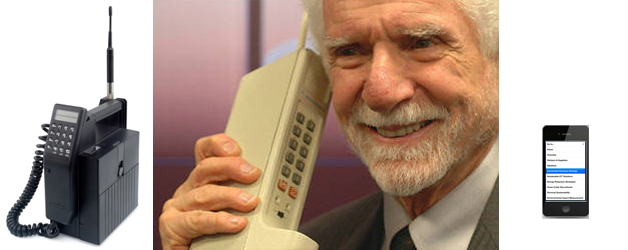
After 40 years, a world gone mobile
April 4, 2013It is 40 years since the advent of the mobile phone, an invention which has changed business and human society.
I was fortunate to have met the first person in the world to make a call from a cellular phone.
In an act as historic as Alexander Graham Bell’s first telephone call, made on March 10, 1876; “Mr Watson. Come here. I want to see you”; a call was made almost a hundred years later, not from, but to Bell Labs. It was competition with Bell Labs and their objective of a car phone, which stimulated the race to the first cellphone.
40 years ago, Dr Joel Engel of Bell Labs took a call from the head of a rival team working on mobile communication technologies, at a much smaller company, Motorola. ”I’m ringing you just to see if my call sounds good at your end,” the caller said.[1]
The Motorola engineer who made that first mobile phone call, on April 3, 1973, was Martin ‘Marty’ Cooper.[2] As he stood on New York’s Sixth Avenue, he used a Motorola DynaTAC 8000X, a entirely portable, self-contained cellphone which weighed one kilogram and had a battery life of just 20 minutes.
Since 1967, the inventor had been working on portable communications for Motorola. The Chicago Police needed hand-held radios and he was using his background in electrical engineering to develop a device. In the course of experimenting with mobile technologies, Cooper devised the concept of a phone which would operate over a cellular network. By 1973, he had created and made the first call with a cell phone.[3]
However, it was not until a decade later (1983), that the mobile phone reached the market.[4]
The earliest models (subsequently referred to as a ‘brick’), were the size of a 12 volt motorcycle battery, with a handset connected by a spring looped cable. A shoulder strap was necessary to lug around these heavy phones. (Like Henry Ford’s Model T, they could be bought “in any colour – as long as it is black.”)
On filming locations, I often used a ‘brick, which was the first alternative to finding the nearest landline or red phone booth. When I purchased my first handheld cell phone in 1988; a massive black Technophone[5] with flat keypad and a whip aerial; it weighed a kilo and cost $5,500!
The greatest advances in cellphone technology have arguably been in battery life and miniaturisation. It has been these two factors which have enabled progressively smaller phones with ever increasing standby time and capacity.
In the intervening decades, the world has gone mobile. With a global human population of over 7 billion in 2012, the number of active cellphones is close to 6 billion.[6][7]
This is equivalent to an 86.7% penetration of the total world population.[8][9]
The percentage of humans over the age of ten is 82.4%, so there are sufficient cellphones for every person alive over the age of ten.[10]
Naturally there is not an even distribution. There are many people in rural and developing countries who do not own a cellphone, just as there are people in major urban centres who do not. However, there are also countries in which cellphone ownership figures exceed the total population. The country which is the world leader is Taiwan with 106.45 cellphones per 100 people (of all ages).[11]
This trend was noticeable in the 1990’s, when in Hong Kong, even ragged rubbish collectors had two cellphones on their belts!
In 2004, I met Marty Cooper at the national launch of Personal Broadband Australia. PBA introduced the first portable wireless broadband device in Australia called “iBurst”. Martin Cooper spoke of ArrayComm[12] and his adaption of a military application (which tracked and modified targeting of missiles in flight), to maintaining a cellular signal as the iBurst device moved (as the user travelled on foot, in a vehicle or train).
Digital Tsunami designed and developed multiple websites for PBA and iBurst, and even a Norwegian language site for iBand which is still online today. PBA was subsequently acquired and the name changed.[13][14]
In 2013, Cooper and the ‘co-inventors’ of the cell phone were awarded the Draper Prize by the US National Academy of Engineering.[15]
Global growth in cellphone ownership will only continue. In 2013, research firm IDC predicts sales of 900 million smartphones, and an equivalent number of basic ‘feature phones’.[16]
With a high definition screen and Internet connection, the smartphone has become a key advertising platform. Mobile advertising spending grew 178% last year to $US4.11 billion, and spending in 2013 is expected to rise a further 77.3% to $US7.29 bn. In the USA in 2012, Digital advertising spend ($US37.31 bn) outstripped Print ($US34.33 bn) and Radio, Directories and Outdoor combined ($US29.78 bn). By 2015, eMarketer projects that Mobile advertising spend alone, will exceed that of both Directories and Outdoor.[17]
The mobile phone sector (phones, batteries, aerials, chips, screens, accessories, mobile sites, apps and games) has become one of the most vibrant drivers of international economic development.
Several years ago, a BBDO Worldwide survey revealed that 26 percent of people felt it was more important to go home to retrieve a cell phone than a wallet. In fact, the smartphone is now replacing the wallet.
The most popular non-voice features are texting, gaming and photography. In a US Sprint survey, almost 66% used their cell phone light to look for something in the dark.
So not only has the smartphone now replaced the telephone, wristwatch, computer, calculator, book, camera, newspaper, street directory, radio, record player, television, dictionary, encyclopedia, diary, Rolodex, filing cabinet, bulletin board, retail store, travel agent, transport timetable, weather report, notepad, photo album, stopwatch and wallet, but even the flashlight!
Sources:
1 Sydney Morning Herald: “Mobile phone turns 40 with little fanfare”
2 Dyna LLC: Marty Cooper background
3 The Brookings Institution: “Invention and the Mobile Economy”
4 The Pittsburgh Post-Gazette: “Cell phone statistics that may surprise you”
5 British: Technophone
6 WolframAlpha: world population and cell phone statistics Wolfram Alpha 5.96 billion cell phones (2011 estimate) against a world population of 7.076 bn (2012).
7 MobiThinking (Google): Latest mobile statistics 5.98 bn cellphones
8 Nationmaster: cell phone statistics
9 Wikipedia: world population statistics
10 US Census Bureau: latest population statistics
11 Sydney Morning Herald Digital Life: “40 years on, mobile phones still pushing consumers’ buttons”
12 Company founded by Marty Cooper: ArrayComm
13 Digital Tsunami: PBA websites
14 Digital Tsunami: iBurst websites
15 National Academy of Engineering and Draper Laboratories: Draper Award (The recipients were Marty Cooper and four other coinventors of the cell phone)
16 IDC: “Worldwide Mobile Phone 2013–2017 Forecast and Analysis” In 2017, IDC projects that total mobile phone shipments will reach 2,281.4 million units worldwide, resulting in a CAGR of 5.6%, 2013-2017
17 eMarketer: “US Total Media Ad Spending by Media 2011-2016”
18 Digital Tsunami: Liberate Your Laptop campaign
19 Digital Tsunami: Meshstream website
20 Digital Tsunami: iBand website
From Our Clients


Working with this team has been a delight and the resulting website far exceeds our expectations. All stages of the process were handled professionally, promptly and creatively. Discussions went smoothly, with flawless communication and suitable and sensible solutions whenever issues were raised. Time frames were either met or delivered early. The site was 100% accurate, indicating impressive attention to detail.
Without exception, the feedback on our site has been outstanding - clear and thoughtful layout, appropriate and interesting graphics and intuitive navigation.


Digital Tsunami provided an outstanding service throughout the whole web development process. Andrew spent extensive time early on to understand our business in order to provide additional conceptual and strategic contributions to the brand and corporate identity of Kinetic Defence Services to ensure the message was clear, precise and appealing to the target audience.
The development process was smooth and efficient and enabled us to have an input throughout to guarantee total satisfaction with the final look and feel of the site.


In taking the time to understand our business, industry and vision, Digital Tsunami created a site which strongly reflects our leadership position in the international market and our strategic direction.
Digital Tsunami's expertise in visual design, information architecture, innovative communication and evocative business writing, resulted in an extremely effective website which will contribute to our continuing expansion across the globe.


I happily recommend Andrew and the Digital Tsunami team.
I have dealt with many web marketing and support companies over the years, and have been very impressed with Digital Tsunami's response, advice and understanding of their field. I recommend talking to Andrew about your next web project.


We were very happy with the development process and the outcome. The objectives have all been achieved, in terms of usability and ease of use in updating the site. You definitely nailed both of these.